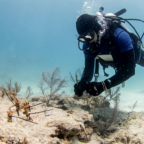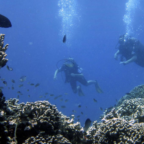
On a 24-hour boat trip off the coast of Western Australia, Dr. Taryn Foster was seeking out a coral reef treasure known as Scott Reef. It was a familiar place for her, as the research associate at the California Academy of Sciences had gone on dives and conducted coral surveys there as part of her postdoctoral work studying coral.
“There’s no tourists out there,” Foster said. “It’s as untouched as you can get these days.”
But Foster found the condition of Scott Reef had changed wildly from years past. She was about to dive into the coral reefs during the worlds’ 2016 mass bleaching event — one of the longest and most severe coral bleaching events on record.
“In a way, it’s actually quite beautiful. The colors are really, really fluorescent — these bright whites, pinks and blues and yellows,” Foster said. “It’s quite spectacular. But you know that what you’re seeing is mass death.”
The sight of the global mass coral bleaching event — a phenomenon that occurs when water is too warm, causing corals to expel the algae living in their tissues and turn completely white — led Foster and her team to start Coral Maker, a collaboration between the California Academy of Sciences and Autodesk. The group’s goal is to use coral science and manufacturing technology to produce one million live corals per year by automating the coral production process, more effectively restoring the ocean’s declining coral population.
The Coral Maker team works across three continents and four time zones, and, now, COVID-19-related work restrictions. With Foster as the founder, several Autodesk employees volunteered their skills and time as part of their work with the Autodesk Foundation, the company’s philanthropic arm.
“Coral reef restoration programs often operate with limited means,” said Shunham Goel, the Coral Maker team lead and a senior engineer manager at Autodesk. “We care deeply about simplicity and efficiency in every aspect of the design process.”
Coral bleaching
The fiery hues of corals can be seen all over the worlds’ ocean floors. While they look like plants, corals are actually animals, and have a mouth, tentacles and a calcium carbonate skeleton.
A coral gets its food from the algae living in its tissues. When thousands of corals connect they form a colony, making up a biodiverse ecosystem. “They’re often compared to rain forests in the terrestrial world, in terms of biodiversity. And they provide structure and habitat and the basis for this marine ecosystem,” Foster said.
Healthy coral reefs provide food and a home to about 25% of all marine creatures in the world. It’s estimated that 6 million fishermen rely on harvesting fish from coral reefs. Reefs also provide coastal protection by reducing the impact of waves on shore, and support local tourist economies that can offer diving excursions.
But mass coral bleaching is threatening the coral ecosystem fast. The world has already lost about 50% of its coral, and by midcentury, it is projected to lose up to 90%, Foster said. The main cause of mass coral bleaching happens when there is an increase in ocean water temperature caused by climate change.
“This stress causes the relationship between the coral and the algae to break down,” Foster said. “And instead of providing the coral with 80% or 90% of its nutrition, the algae is now becoming toxic to the coral.”
The corals starve from malnutrition, and often never recover.
But hope isn’t lost: Teams have been working on worldwide coral restoration for years. The nonprofit Coral Restoration Foundation has restored 120,000 corals since 2007. And according to the US National Oceanic and Atmospheric Administration, more than 20 active nurseries are active in the Caribbean, providing more than 40,000 healthy corals for reef restoration each year.
However, these programs run into one main problem: scaling their efforts. Current restoration methods, such as coral gardening, are done manually and are very time consuming, Foster said.
Another bottleneck for scaling is the slow coral growth rate. “To get from a 10 centimeter fragment to an adult colony can take anywhere from 3 to 10 years, depending on which species you’re talking about,” Foster said.
Mass-producing live corals
To address the coral scaling issue, Foster and the Coral Maker team are combining science, manufacturing technology and traditional manufacturing techniques to offer a solution.
The design idea begins with a premade coral skeleton. The skeleton has a dome-shaped base made from stone material, similar to corals’ natural calcium carbonate skeletons. To mass produce the skeleton, Coral Maker is using dry cast molding, a traditional masonry manufacturing technique that could potentially produce 4,000 stone coral skeletons per day.
Once the skeleton is made, a robotic arm inserts seed plugs with live coral fragments into the skeleton. The seeding process previously had to be done by hand, Goel said. To produce a million corals each year, multiple domes with seed plugs need to be assembled every minute. The robotic arm uses vision sensors, and machine learning to precisely locate the position of the dome and seed plugs and to install the seeds in the right place.
After the new corals have been deployed to the ocean, they will grow naturally and recoat the surface of the skeleton, fusing together with corals of the same genotype, eventually forming an adult-size coral colony.
By providing the coral with a premade skeleton, it doesn’t have to calcify its skeleton from scratch. This will reduce the time taken to reach adult size from the current 3 to 10 years to about 6 to 18 months, Foster said.
From manufacturing site to ocean floors
By the end of 2020, all this hard work will be put to the test. By the end of the year, Coral Maker is planning to deploy prototypes with real coral fragments into the ocean, collect data and make improvements to the design. Though the pandemic has shut down the team’s prototyping facility, researchers are using home 3D printers to keep the plan on track.
“If action is not taken now, the corals won’t be there for the next generation,” Goel said.
Long term, selecting an ocean site location with higher latitudes could help these new corals stay alive, Foster said.
“We know that corals did exist at higher latitudes, as in further away from the tropics, in the last interglacial period. So they have, they have the ability to move,” Foster said. The problem is that it takes 5 to 10 thousand years to move on their own.
“If we could set up a reef at a meaningful scale at a high latitude, then maybe we could create little pockets of survivors,” Foster said.
While Coral Maker and scientists all over the world work on these solutions to regrow the ocean’s coral reefs, anyone can take small steps to change their ecological footprint every day. If we do make strides to end climate change, the little coral survivors that Coral Maker is producing will have a better chance of making it to the next generation.
“If people have awareness of climate change — if they’re willing to change their own behavior, but also advocate for change — then I think that’s what’s going to have the biggest impact,” Foster said.















Social Profiles